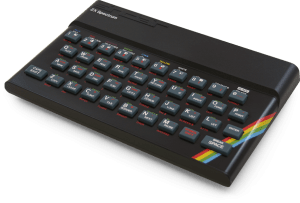This month Technical Towers has been awash with discussion about tech. We’ve touched on everything from past tech, current tech, future tech and even tech we wish existed.
Never ones to shy away from a challenge, we then entered into the ultimate tech discussion – when push comes to shove, what would we say is our favourite piece of tech? Obviously we had to set a few rules to avoid getting into the realms of robotic legs and remote controlled socks, so we settled upon only being allowed to include tech that we have actually owned at some point in our lives. The results could not have been more different…
Sinclair ZX Spectrum – James Royce, Digital Lead

My favourite piece of tech has to be the Sinclair ZX Spectrum (the rubber keyed version that is, not the later Amstrad incarnations). I spent much of the early 1980’s sitting on the living room floor keying in code from the pages of Your Sinclair magazine or trying to complete Manic Miner (a task incidentally that still eludes me over 30 years on). The Spectrum was absolutely instrumental in fuelling the geek within me and steering me on the path to where I am now and my only regret is that I no longer own one.
Borne out of the ‘ZX81 Colour’ or ‘ZX82’ project, the successor to the ZX81, the Spectrum was launched on the 21st April 1982 and was available with either 16k or 48k of RAM (memory). Surviving five major upgrades and helped no doubt, by being sold to the consumer electronics marketing machine that was Alan Sugar’s Amstrad in the mid 80’s, the Spectrum, in all its guises, sold around 5 million units until finally being discontinued in 1992.
A lesser known fact though was the existence of a reasonable market in unofficial clones across eastern Europe, Russia and India. A UK attempt at a clone, the much (at the time) hyped MGT Sam Coupe, failed to compete with the Commodore Amiga and Atari ST and left MGT in receivership.
The Spectrum it seems is about to experience a whole new lease of life in the guise of the ZX Spectrum Vega, a handheld clone capable of running, it is claimed, all of the 14,000+ software titles developed for the original machine.
The Vega is being marketed by Luton based Retro Computers Ltd of which Sir Clive Sinclair’s company, Sinclair Research Ltd, is a shareholder and will be built, apparently, here in the UK. Will I be queuing up for one? Probably not, but if you do have an old Spectrum kicking around and looking for a new home, I’d love to hear from you!
The Apple iPhone – Adam Chamberlin, Web Developer

I do have a confession to make before we start. I queued for my first iPhone.
After the keynote by Steve Jobs back in January 9th 2007, I waited patiently for the UK release on November the 9th. Having watched how popular the device was during the US launch I decided to beat the rush. Little did I know that Sudbury was not the tech metropolis I thought it was, resulting in only one person standing outside the mobile phone shop!
The iPhone was not my first smart phone, I had a Sony Ericcson P900 before which could be classified as smart. Also in my possession was an iPod, a iPAQ palm device and a laptop. All of these were used in my daily routines in one way or another. It was combining all these devices into one that really made it for me. The contents of my rucksack shrank. In fact, most of the times my entire gadget repertoire could now fit in one pocket. Life changing!
One could argue that there were plenty of mobile devices out there that could offer similar specifications, but just take a quick glance at mobile phones before the iPhone. It revolutionised how people thought of a phone. Competitors suddenly needed to re-think the use of hardware keyboards and colour screens, your device looked so antiquated next to a full touch screen. A touch screen with swiping and pinching. Magical!
In 2007 we were in the throws of web 2.0 (what ever that actually turned out to be). People were getting used to social networking, Twitter was turning one and growing, Facebook had just developed pages and YouTube rolled out the 3GP format on it’s 320x240pixel resolution videos. Yet in my hand was a device that could access the internet, not just a cut down WAP version but the full blown internet. Mind blown!
The iPhone means the most to me for what it started and how it changed how we think. For a start lets look at the internet we could now access, on a mobile phone in your pocket. This kicked off the ‘responsive’ web design era. Sites are now expected to work on all devices of any size.
With future releases of the iPhone, we were introduced to the concept of an app. An application I could install on the phone to extend its functionality. True, I could try and do this with my old Sony Ericsson; if I wanted to waste a few hours with limited success. Off the back of the ‘app’ we got the multi-billion dollar app development industry.
Looking towards the future, newer iPhones are changing how we communicate with Face Time video and with Apple Pay it could change how we handle money.